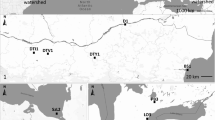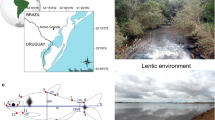Abstract
Round goby (Neogobius melanostomus) is a benthic freshwater fish native to the Ponto-Caspian region in Europe that was first recorded in the Laurentian Great Lakes basin in 1990 in the St. Clair River in Sarnia, Ontario. It has since become one of the major invasive species of the Great Lakes. The mechanisms through which round goby has become a successful invader are poorly understood. It has been hypothesized that phenotypic plasticity of species may influence their establishment, spread, and impact. If a species is phenotypically plastic, it could more easily adapt to a variety of environments. We examine whether phenotypic variation is present in round goby in the Laurentian Great Lakes and whether morphological variation in dorsal and lateral shape is related to habitat type and time since invasion. Morphological variation in preserved round goby specimens was analyzed for dorsal and lateral shape differences between lake, large river, and river habitats, waterbody of origin (Erie, Huron, Michigan, Ontario, Simcoe) and time since initial invasion (i.e., early, mid, recent) using a Procrustes ANOVA and visualized using a principal component analysis. There is significant variation in body shape among lake and river populations, which may be due to differences in water flows between these habitats. Lake specimens have an overall deeper body shape, whereas river specimens have an overall shallow body shape and large river specimens are intermediate in shape. The results of this study help better understand what morphological mechanisms facilitate invasions and provide valuable information for management decisions related to spread of round goby in the Great Lakes basin.






Similar content being viewed by others
Data Availability
The datasets and code generated for this study are available from the corresponding author on reasonable request.
References
Adams DC, Otrola-Castillo E (2020) Geomorph: an R package for the collection and analysis of geometric morphometric shape data. Methods Ecol Evol 4:393–399. https://doi.org/10.1111/2041-210X.12035
Adams D, Collyer M, Kaliontzopoulou A (2020) Geomorph: software for geometric morphometric analyses. R Package Version 3(2):1
Azzurro E, Tuset VM, Lombarte A, Maynou F, Simberloff D, Rodríguez-Pérez A, Solé RV (2014) External morphology explains the success of biological invasions. Ecol Lett 17:1455–1463. https://doi.org/10.1111/ele.12351
Baker HG (1965) Characteristics and modes of origin of weeds. In: Baker HG, Stebbins GL (eds) The genetics of colonizing species. Academic Press, New York, pp 147–169
Balshine S, Verma A, Chant V, Theysmeyer T (2005) Competitive interactions between round gobies and logperch. J Great Lakes Res 31:68–77. https://doi.org/10.1016/S0380-1330(05)70238-0
Binning SA, Roche DG (2015) Water flow and fin shape polymorphism in coral reef fishes. Ecology 96:828–839. https://doi.org/10.1890/14-0426.1
Bookstein FL (1991) Morphometric tools for landmark data: geometry and biology. Cambridge University Press, Cambridge
Brandner J, Cerwenka AF, Schliewen UK, Geist J (2013) Bigger is better: characteristics of round gobies forming an invasion front in the Danube River. PLoS ONE 8:9. https://doi.org/10.1371/journal.pone.0073036
Brandner J, Cerwenka AF, Schliewen UK, Geist J (2018) Invasion strategies in round goby (Neogobius melanostomus): is bigger really better? PLoS ONE 13:1. https://doi.org/10.1371/journal.pone.0190777
Brinsmead J, Fox MG (2002) Morphological variation between lake- and stream-dwelling rock bass and pumpkinseed populations. J Fish Biol 61:1619–1638. https://doi.org/10.1111/j.1095-8649.2002.tb02502.x
Brown JE, Stepien CA (2008) Invasion genetics of the Eurasian round goby in North America: tracing sources and spread patterns. Mol Ecol 18:64–79. https://doi.org/10.1111/j.1365-294X.2008.04014.x
Carman SM, Janssen J, Jude DJ, Berg MB (2006) Diel interactions between prey behaviour and feeding in an invasive fish, the round goby, in a North American river. Freshw Biol 51:742–755
Cerwenka AF, Alibert P, Brandner J, Geist J, Schliewen UK (2014) Phenotypic differentiation of Ponto-Caspian gobies during a contemporary invasion of the upper Danube River. Hydrobiologia 721:269–284. https://doi.org/10.1007/s10750-013-1668-5
Cerwenka AF, Pagnotta A, Böker C, Brandner J, Geist J, Schliewen UK (2017) Little association of biological trait values with environmental variables in invasive alien round goby (Neogobius melanostomus). Ecol Evol 7:4076–4085. https://doi.org/10.1002/ece3.2942
Collyer ML, Adams DC (2018) RRPP: an R package for fitting linear models to high-dimensional data using residual randomization. Methods Ecol Evol 9:1772–1779. https://doi.org/10.1111/2041-210X.13029
Collyer ML, Adams, DC (2020) RRPP: linear model evaluation with randomized residuals in a permutation procedure, R package version 0.5.2
Cross EE, Rawding RS (2009) Acute thermal tolerance in the round goby, Apollonia melanostoma (Neogobius melanostomus). J Therm Biol 34:85–92
Dashinov D, Czerniejewski P, Balshine S, Synyshyn C, Tasheva-Terzieva E, Stefanov T, Ivanova P, Mandrak N, Uzunova E (2020) Variation in external morphology between the native and invasive populations of the round goby, Neogobius melanostomus (Actinopterygii: Gobiidae). Zoomorphology 139:361–371. https://doi.org/10.1007/s00435-020-00480-7
Drake DAR, Mandrak NE (2014) Bycatch, bait, anglers, and roads: quantifying vector activity and propagule introduction risk across lake ecosystems. Ecol Appl 24:877–894. https://doi.org/10.1890/13-0541.1
Gaston KA, Lauer TE (2014) Morphometric variation in bluegill Lepomis macrochirus and green sunfish Lepomis cyanellus in lentic and lotic systems. J Fish Biol 86:317–332. https://doi.org/10.1111/jfb.12581
Grigorovich IA, Korniushin AV, Gray DK, Duggan IC, Colautti RI, MacIsaac HJ (2003) Lake Superior: an invasion coldspot? Hydrobiologia 499:191–210. https://doi.org/10.1023/A:1026335300403
Hôrková K, Kováč V (2013) Different life-histories of native and invasive Neogobius melanostomus and the possible role of phenotypic plasticity in the species’ invasion success. Knowl Manag Aquat Ecosyst 412:01. https://doi.org/10.1051/kmae/2013081
MacInnis AJ, Corkum LD (2000a) Fecundity and reproductive season of the round goby Neogobius melanostomus in the Upper Detroit River. Trans Am Fish Soc 129(1):136–144. https://doi.org/10.1577/1548-8659(2000)129%3c0136:FARSOT%3e2.0.CO;2
Hôrková K, Kováč V (2015) Ontogenetic phenomena, temporal aspect, and ecological factors in the successful invasion of round goby Neogobius melanostomus in the River Danube. Aquat Invasions 10:227–235. https://doi.org/10.3391/ai.2015.10.2.11
Imre I, Mclaughlin RL, Noakes DL (2002) Phenotypic plasticity in brook charr: changes in caudal fin induced by water flow. J Fish Biol 61:1171–1181. https://doi.org/10.1111/j.1095-8649.2002.tb02463.x
Istead A, Yavno S, Fox M (2015) Morphological change and phenotypic plasticity in response to water velocity in three species of Centrarchidae. Can J Zool 93:879–888. https://doi.org/10.1139/cjz-2015-0096
Jude DJ, Reider RH, Smith GR (1992) Establishment of Gobiidae in the Great Lakes basin. Can J Fish Aquat Sci 49:416–421. https://doi.org/10.1139/f92-047
Kornis MS, Mercado-Silva N, Zanden MJ (2012) Twenty years of invasion: a review of round goby Neogobius melanostomus biology, spread and ecological implications. J Fish Biol 80:235–285. https://doi.org/10.1111/j.1095-8649.2011.03157.x
Kováč V (2010) Developmental plasticity and successful fish invasions. In: Proceedings of 17th International Conference on Aquatic Invasive Species, 29 August – 2 September 2010, San Diego, 159
L’avrinčíková M, Kováč V (2007) Invasive round goby Neogobius melanstomus from the Danube mature at small size. J Appl Ichthyol 23:276–278. https://doi.org/10.1111/j.1439-0426.2007.00851.x
MacInnis AJ, Corkum LD (2000b) Age and growth of round goby Neogobius melanostomus in the upper Detroit River. Trans Am Fish Soc 129:852–858. https://doi.org/10.1577/1548-8659(2000)129%3c0852:AAGORG%3e2.3.CO;2
Novomeská A, Katina S, Copp GH, Pedicillo G, Lorenzoni M, Pompei L, Cucherousset J, Kováč V (2013) Morphological variability of black bullhead Ameiurus melas in its non-native European populations. J Fish Biol 82:1103–1118. https://doi.org/10.1111/jfb.12035
Pettitt-Wade H, Wellband KW, Heath DD, Fisk AT (2015) Niche plasticity in invasive fishes in the Great Lakes. Biol Invasions 17:2565–2580. https://doi.org/10.1007/s10530-015-0894-3
Pohlman CL, Nicotra AB, Murray BR (2005) Geographic range size, seedling ecophysiology and phenotypic plasticity in Australian Acacia species. J Biogeogr 32:341–351. https://doi.org/10.1111/j.1365-2699.2004.01181.x
Polacik M, Janac M, Vassilev M, Trichkova T (2012) Morphometric comparison of native and nonnative populations of round goby Neogobius melanostomus from the River Danube. Folia Zoology 61:1–8. https://doi.org/10.25225/fozo.v61.i1.a2.2012
R Core Team (2020) R: A language and environment for statistical computing. R Foundation for Statistical Computing, Vienna, Austria. Version 3.6.3
Ren M, Zhang Q (2009) The relative generality of plant invasion mechanisms and predicting future invasive plants. Weed Res 49:449–460. https://doi.org/10.1111/j.1365-3180.2009.00723.x
Robinson BW, Wilson DS, Margosian AS, Lotito PT (1993) Ecological and morphological differentiation of pumpkinseed sunfish in lakes without bluegill sunfish. Evol Ecol 7:451–464. https://doi.org/10.1007/BF01237641
Robinson BW, Wilson DS (1994) Character release and displacement in fishes: a neglected literature. Am Nat 144:596–627. https://doi.org/10.1086/285696
Robinson BW, Wilson DS, Margosian AS (2000) A pluralistic analysis of character release in pumpkinseed sunfish (Lepomisgibbosus). Ecol 81:2799–2812. https://doi.org/10.2307/177342
Robinson BW, Parsons KJ (2002) Changing times, spaces, and faces: tests and implications of adaptive morphological plasticity in the fishes of northern postglacial lakes. Can J Fish Aquat Sci 59:1819–1833. https://doi.org/10.1139/f02-144
Rohlf JF (2016) TPSUtil64 Ecology and Evolution. SUNY at Stony Brook, New York, USA
Rohlf JF (2017) tpsDig2 Ecology and Evolution and Anthropology. Stony Brook University, New York, USA
Rohlf JF, Marcus LF (1993) A revolution in morphometrics. Trends Ecol Evol 8:129–132. https://doi.org/10.1016/0169-5347(93)90024-J
Samways KM, Leavitt PR, Magnan P, Rodríguez MA, Peres-Neto PR (2015) Convergent polymorphism between stream and lake habitats: the case of brook char. Can J Fish Aquat Sci 72:1406–1414. https://doi.org/10.1139/cjfas-2015-0116
Sisneros JA, Alderks PW, Leon K, Sniffen B (2009) Morphometric changes associated with the reproductive cycle and behaviour of the intertidal-nesting, male plainfin midshipman. Porichthys notatus 74:18–36. https://doi.org/10.1111/j.1095-8649.2008.02104.x
Skόra K, Olenin S, Gollasch S (1999) Neogobius melanostomus (Pallas, 1811). In: Gollasch S, Minchin D, Rosenthal H (eds) Case histories on introduced species: their general biology, distribution, range expansion and impact. Logos-Verlag, Berlin, pp 69–73
Simonovic P, Paunović M, Popović S (2001) Morphology, feeding, and reproduction of the round goby, Neogobius melanostomus (Pallas), in the Danube River basin, Yugoslavia. J Great Lakes Res 27:281–289. https://doi.org/10.1016/S0380-1330(01)70643-0
Tomeček J, Kováč V, Katina S (2005) Ontogenetic variability in external morphology of native (Canadian) and non-native (Slovak) populations of pumpkinseed (Lepomis gibbosus, Linnaeus 1758). J App Ichythyol 21:335–344. https://doi.org/10.1111/j.1439-0426.2005.00678.x
Tomeček J, Kováč V, Katina S (2007) Biological flexibility of pumpkinseed, a successful coloniser throughout Europe. In: Gherardi F (ed) Freshwater bioinvaders: profiles, distribution, and threats. Springer, Verlag, pp 307–336
Yavno S, Fox MG (2014) Morphological plasticity of native and non-native pumpkinseed sunfish in response to habitat type. Evol Ecol Res 16:373–395. https://doi.org/10.1111/jeb.12230
Záhorská E, Kováč V, Falka I, Beyer K, Katina S, Copp GH, Gozlan RE (2009) Morphological variability of the Asiatic cyprinid, topmouth gudgeon Pseudorasbora parva, in its introduced European range. J Fish Biol 74:167–185. https://doi.org/10.1111/j.1095-8649.2008.02121.x
Záhorská E, Švolíková K, Kováč V (2013) Do invasive populations of topmouth gudgeon (Pseudorasbora parva, Temminck and Schlegel) from disturbed and undisturbed habitats follow different life-histories? Int Rev Hydrobiol 98:61–70. https://doi.org/10.1002/iroh.201201446
Acknowledgements
We thank the Royal Ontario Museum for use of their equipment and specimens.
Author information
Authors and Affiliations
Contributions
N.E.M. and C.C.R. co-conceived the idea for the paper. N.E.M. reviewed, edited the work, and mentored throughout the completion of the project. C.C.R. completed the literature review of the subject, took the photographs, landmarked the images in TPS software, helped complete the analysis, and wrote the manuscript. S.E.C. helped complete statistical analysis and edited the manuscript.
Corresponding author
Ethics declarations
Ethics
This study did not include any research on living animals requiring ethical clearance.
Conflict of interest
The authors declare no competing interests.
Additional information
Publisher's note
Springer Nature remains neutral with regard to jurisdictional claims in published maps and institutional affiliations.
Rights and permissions
About this article
Cite this article
Rawlings, C.C., Campbell, S.E. & Mandrak, N.E. Body shape variation in round goby Neogobius melanostomus in the Laurentian Great Lakes basin. Environ Biol Fish 104, 1089–1102 (2021). https://doi.org/10.1007/s10641-021-01138-z
Received:
Accepted:
Published:
Issue Date:
DOI: https://doi.org/10.1007/s10641-021-01138-z




